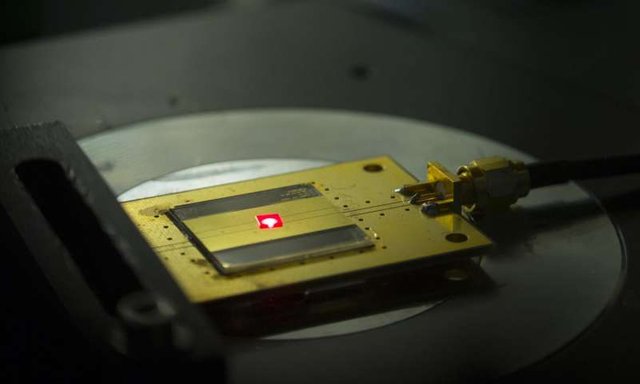Harvard experts created a diamond from the smallest radio in the world

This radio receiver - only the beginning of work in the future, scientists plan to use diamonds and other properties to create miniature radio-electronic elements
Researchers from SEAS (Harvard John A. Paulson School of Engineering and Applied Sciences) have created the smallest radio in the world of pink diamonds. More specifically, the receiver does not play a role of the diamonds themselves, and microscopically small defects in the crystal lattice size of a few atoms. The very tiny radio formed of blocks, the size of which is two atoms. Work a receiver can in the most adverse conditions where any electronic device simply fails. This may be the surface of Venus, the mouth of the volcano. You can use a similar system and in medicine - for example, to use such a module as a pacemaker.
The head of the development team began Marko Lončar. He and his graduate student Linbo Shao had the idea to use a diamond point defects, which are known as nitrogen-vacancy in diamond. Sam defect constitutes a breach of the diamond crystal lattice structure that occurs when removing carbon atoms from the lattice site and linking the vacancy with the nitrogen atom.
The uniqueness of this defect is that its properties are very similar to the properties of the atom, whether the "frozen" in the crystal lattice of the diamond: the electron spins of the individual center is easily manipulated: light; magnetic, electric and microwave fields; - That allows you to record quantum information (qubits) in the center of the core back. Such manipulation is possible even at room temperature; Center has a long (reaching several milliseconds) during storage of induced spin polarization ... Currently - NV-center can be considered as a basic element of future quantum logic processor needed for a quantum computer, quantum communication links with the security protocol and other applications of spintronics.
In order to create a nitrogen-substituted position, researchers replaced carbon atom in tiny diamond on a nitrogen atom by removing one of the neighboring atoms. As a result, a system formed from a nitrogen atom and a "hole." Jobs may be used for single photon emission or detection of a weak magnetic field. Systems of this type are inherent photoluminescent properties, which means the ability to convert information into light. This opens up the possibility of using nitrogen-vacancies in quantum computing, photonics and other fields.
Even high purity natural and synthetic (IIa-type) contains a small concentration of diamond NV-centers. (High purity synthetic diamond manufactured by a chemical vapor deposition (CVD)). If insufficient concentration of centers, then irradiated and annealed samples. Irradiation are high-energy particles (10-80 keV); it may be a stream of electrons, protons, neutrons and gamma particles. NV-centers are established to a depth of 60 microns. Interestingly, NV0 generally occur up to 0.2 m deep. Created job at room temperature inactive, but at higher temperatures (above 800C) their mobility considerably grows. The nitrogen atom, is inserted in the grille, captures one of the vacancies and the other creates a neighboring vacancy NV-.
Regarding the radio, they generally consist of five basic components: a power source, receiver, transmitter, which converts the electromagnetic waves into electrical current, and the controller dynamics. The system, created by Harvard experts have all of these components, while not in the form in which we are accustomed to seeing them.
The source of energy here - the laser beam, which is directed to the electrons in the nitrogen-vacancy. Electrons are sensitive to the electromagnetic field, so that they are exposed to the laser beams responding to radio. When a job detects a radio wave, it converts it into a red light, which is routed through the photodiode (in this case transformer). It transforms light into current. Then the current is converted into sound using a speaker.
But what about the configuration of the receiver? This, too, scientists have solved the problem. They have created a magnetic field around the diamond, which can be controlled to change the frequency of radio waves perceived job. The signal may be amplified, if you work with a large number of vacancies. The work of researchers from the SEAS used billions of point defects in diamond. Work the system can and with one vacancy, but, unfortunately, in this case, can only emit one photon at a time, instead of the red light flux.
In the future, the research team hopes to explore the possibility of working with other defects atoms, such as silicon vacancies in diamonds. Perhaps it will help to better manage the airwaves.
When conducting trial tests diamond radio scientists worked, including at elevated temperatures - about 350 degrees Celsius.
"The unique properties of diamond," - says the project manager. "This radio receiver can operate in space, or under difficult conditions in the human body."
The study was supported by research center STC Center for Integrated Quantum Materials.
This post has been ranked within the top 80 most undervalued posts in the second half of Dec 20. We estimate that this post is undervalued by $4.63 as compared to a scenario in which every voter had an equal say.
See the full rankings and details in The Daily Tribune: Dec 20 - Part II. You can also read about some of our methodology, data analysis and technical details in our initial post.
If you are the author and would prefer not to receive these comments, simply reply "Stop" to this comment.